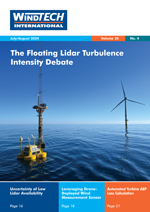 Recently I came across a website [1] that lists the reports on various wind turbine failures or complaints made about wind turbine accidents in the neighborhood. Although the list may not reflect all the cases, it is a good representation of the real world and what has happened involving wind turbines. The list is extensive and covers the incidents in all countries since 2005.
Recently I came across a website [1] that lists the reports on various wind turbine failures or complaints made about wind turbine accidents in the neighborhood. Although the list may not reflect all the cases, it is a good representation of the real world and what has happened involving wind turbines. The list is extensive and covers the incidents in all countries since 2005.
By Ahmad Hemami, McGill University, Montreal, Canada
Certain problems associated with wind turbines and the complaints about them existed from the early days. Maybe we can refer to those problems (effect on the ecosystem, effect on birds and bats, effect on sea mammals, shadow flicker, noise) as classical. Among these classical problems some were dealt with and there are solution(s), but some cannot be resolved. For instance, shadow flicker and turbine noise are certain, and the solution to them is the minimum distance from a wind farm to the neighbouring residential areas. For sure a minimum distance of 1000 feet is not sufficient at all, particularly as the size of turbines has grown. 1000 m sounds much better. Here, the authorities to handle/issue permits have the responsibility of taking care of determining the minimum distance of a wind farm from residential areas, which would take into account various factors. Thus, any new complaint about these issues reflects the fact that some people did not do their job properly.
On the other hand, the problem of birds killed by wind turbines (also a classic problem) has not been solved yet, except perhaps for migrating birds. Nonetheless, as the data shows, the number of birds killed by cats and windows is much much higher than those killed by wind turbines. This is exemplified in Table 1 for North America, but it can represent the relative data for other parts of the world. The data in Table 1 is a little old and the numbers are based on estimation. Surely, research of this nature is very difficult, costly and time-consuming. The data is extracted from references [2] and [3].
The topic of this discussion is the failure of wind turbines, apart from the classical issues. Whereas any sort of turbine failure is not desirable, failures can be divided into two types. We may refer to them as internal and external. An internal failure is one that results from malfunction or failure of a component and leads to the shut-down of a turbine. The consequence is losing production; that is, a financial loss until the repairs are done and a turbine gets back to operation. An external failure is much more serious; it involves not only the turbine shut down and a much larger financial loss, but it also has bad effects on the environment and the surrounding area. These are mainly turbine catching fire, blade throw, and the whole turbine structural failure and collapse.
An analysis of the data in [1] from January 2018 to May 2024 reveals that there have been 30 blade breakage and 49 turbine fires. In one case the fire was due to lightning and starting from a blade. But in other cases, the fire in the nacelle is due to two obvious reasons: overheating and/or oil leakage.
More recently, on May 24, 2024, five turbines in Iowa, USA were destroyed by a tornado. This kind of failure by natural phenomena, though undesirable, is inevitable and presently nothing can be done about it. However, nacelle fires represent insufficient and improper maintenance work, and blade falls denote incorrect engineering or bad manufacturing work. Altogether, the number of occurrences of both of those is too high.
By today’s standards the operating conditions and performance of all wind turbines can be remotely monitored, and the necessary action can be taken in the case of abnormalities and malfunctioning. Most of the above-mentioned 79 incidents have occurred in onshore wind farms. Nobody expects on-site human supervisory of all these automated machines. But all have remote supervisory through SCADA or similar systems. Although the cause of each incident is not revealed, nacelle fire cannot be caused by anything other than oil leakage and overheating. In both cases, if it happens in the generator or in the gearbox, there is sufficient time for the system to stop before it leads to catching fire. Oil spills in the nacelle can sometimes be attributed to careless maintenance work (not proper cleaning).
In the case of blade failure, it is obvious that a failure of any form cannot simultaneously happen in all blades; more likely it takes place in one blade, and it is not a sudden event. This implies that (depending on the nature of the failure) some imbalance and vibrations could be sensed for some time, with an increasing rate, prior to the unavoidable ending. We cannot expect these machines to work on their own without being equipped with measuring devices for all potential faults.
As the turbines become larger and more expensive, losing even one turbine is a big loss. And this is more significant for offshore turbines, although they cannot fall on someone’s house or spread fire in trees and forests. Good maintenance may be (or look) more expensive, but it is always worth the cost in the end.
Further Reading
- https://www.windaction.org/posts?topic=24&p=47
- Scott R. Loss, Tom Will, and Peter P. Marra, ‘Direct Mortality of Birds from Anthropogenic Causes’, https://www.annualreviews.org/content/journals/10.1146/annurev-ecolsys-112414-054133
- 9 leading causes of bird deaths in Canada; https://www.cbc.ca/news/politics/9-leading-causes-of-bird-deaths-in-canada-1.1873654








